|
by Victor LOH Weng Keong, HWANG Siew Wai, CHIN Khong Ling, Dujeepa D. SAMARASEKERA, Yanika KOWITLAWAKUL
 he Singapore polyclinic has evolved to efficiently
provide a comprehensive range of services to screen,
prevent, and manage the range of medical conditions
of epidemiological importance to the Singapore population. These
services range from the immunization and screening of children,
to the care of elderly patients with multiple chronic medical
conditions (medical conditions that require long-term medication
and follow up). In this article, we write about a qualitative study
to evaluate the reactions of medical students to a mobile app
employed to learn about healthcare services within the polyclinic. he Singapore polyclinic has evolved to efficiently
provide a comprehensive range of services to screen,
prevent, and manage the range of medical conditions
of epidemiological importance to the Singapore population. These
services range from the immunization and screening of children,
to the care of elderly patients with multiple chronic medical
conditions (medical conditions that require long-term medication
and follow up). In this article, we write about a qualitative study
to evaluate the reactions of medical students to a mobile app
employed to learn about healthcare services within the polyclinic.
Polyclinic Services
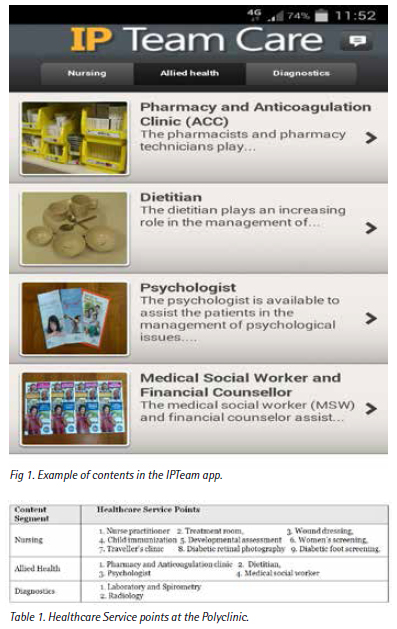 In the 2010 Primary Care Survey1 conducted by the Ministry of
Health, of the close to 12,000 patients who consulted at the then
18 polyclinics in one day (at present, there are 19 polyclinics), 40%
of the consultations were primarily for chronic medical conditions.
Typically an individual patient with chronic disease will be seen by
a team of healthcare professionals at various service points within
the polyclinic. For instance, a patient with diabetes mellitus gets
his blood taken by the laboratory technician, he may then have
his eyes checked at the retinal photography station, get his feet
checked for numbness at the nursing station, have a medical
consult with the family physician, and then collect the medication
that is dispensed by the pharmacist. In addition, he may have an
appointment at the dietitian's office with his wife, and he may
need to consult the nursing-trained care manager to learn about
home glucose monitoring.
In the 2010 Primary Care Survey1 conducted by the Ministry of
Health, of the close to 12,000 patients who consulted at the then
18 polyclinics in one day (at present, there are 19 polyclinics), 40%
of the consultations were primarily for chronic medical conditions.
Typically an individual patient with chronic disease will be seen by
a team of healthcare professionals at various service points within
the polyclinic. For instance, a patient with diabetes mellitus gets
his blood taken by the laboratory technician, he may then have
his eyes checked at the retinal photography station, get his feet
checked for numbness at the nursing station, have a medical
consult with the family physician, and then collect the medication
that is dispensed by the pharmacist. In addition, he may have an
appointment at the dietitian's office with his wife, and he may
need to consult the nursing-trained care manager to learn about
home glucose monitoring.
Medical School
At the Yong Loo Lin School of Medicine, National University of
Singapore (NUSmed), students are posted to designated polyclinics
in groups of 7–8 as a component of the family medicine posting
in the third-year of the curriculum. With the burden of chronic
disease projected to increase in tandem with the rapidly ageing
population, medical students need to understand the range of
healthcare services available for the comprehensive care of patients
within the polyclinic setting.
Mobile Application
In order to structure learning about the range of healthcare services
at the polyclinic, we leveraged on the high (87% according to
Nielsen2) mobile phone ownership in Singapore, and hypothesized
that the use of a mobile app to learn about the roles and services
at polyclinic service-points would be well received by Generation
Y learners. We felt that the mobile app would be an ideal platform
for self-directed learning by guiding students as they made their
way around the busy polyclinic from point to point, and providing
just-in-time educational interactions at each point-of-care.
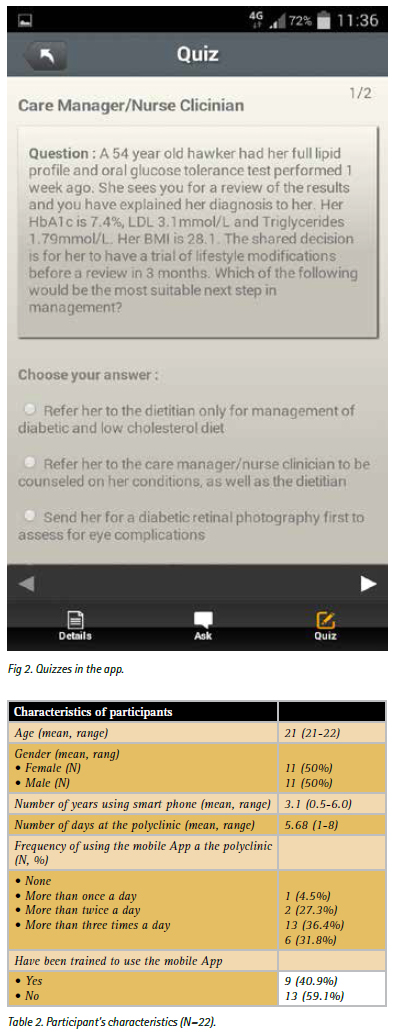 We named the app "IPTeam Polyclinic": "IPteam" in order to
recognize the inter-professional nature of the team of healthcare providers at the polyclinic, and "polyclinic" to situate the context
in which the learning app was to be used. We named the app "IPTeam Polyclinic": "IPteam" in order to
recognize the inter-professional nature of the team of healthcare providers at the polyclinic, and "polyclinic" to situate the context
in which the learning app was to be used.
In order to organize the content in the app, fifteen healthcare
service points common to both Singhealth and National Healthcare
Group polyclinics were categorized into one of three content
segments: Nursing, Allied Health, and Diagnostics (Table 1, Fig
1).
Educational interactions were designed for each point-of-care.
The 'Before' activity introduced the service and learning objectives.
An 'Ask' section provided questions for encouraging discussion
with the designated healthcare professional. On average students
stayed at each service point for 30–45 minutes. Students are
quizzed with multiple-choice questions 'After' leaving each service
point. Figure 2 represents an example of a quiz in the app.
Qualitative Study
An exploratory qualitative study using focus group interviews was
conducted in Aug 2013 to evaluate the reactions of third-year medical students toward using the IPTeam mobile application at
the Polyclinic. The study research questions were:
- What were the reactions of third-year medical
students towards the IPTeam app used for learning
about the healthcare services at the polyclinic?
- What factors encouraged students to use the mobile
application?
- What challenges did students encounter when using
the mobile application?
Purposive sampling was used with students who used the
IPTeam app during their rotation to the polyclinic. Students who
were absent, or who did not use the mobile app were excluded from
the sample. In this study, there were three focus group discussions
and a total of 22 students were interviewed. This was adequate
(two to five focus groups recommended) for the emergence of
categories across and between groups, and for data saturation to be reached.
Table 2 presents the demographic data of the participants.
The study had 22 participants, with an equal number of males
(N=11) and females (N=11). The average age of participants was
21-years-old, with age range between 21- to 22-years-old. All
participants used their smartphones for at least six months. All
the participants had been at the polyclinic for a minimum of one
day to a maximum of eight days. The majority of participants
used the application more than twice a day for their learning and
most of the participants used the mobile application without prior
training.
Prior ethical approval was obtained from the university
Institutional Review Board (IRB). Semií¬structured open-ended
questions were used for the interviews. The interview questions
and prompts were developed based on literature reviews, and the
modified Acceptance Model. An integrated circuit recorder was
used to record discussions for data accuracy, and data collection
was continued until data saturation was reached. Table 3 presents
the examples of questions and prompts used to guide the
interviews.
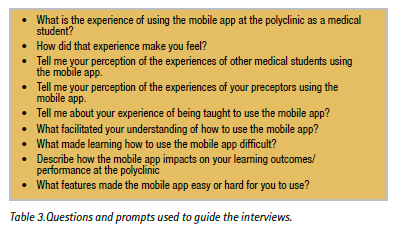 Data Analysis
Data Analysis
Descriptive statistics was used to analyze the participants'
demographic data. Interview records were transcribed verbatim,
and the content analysis method was used to analyze the data. This
method involved coding and developing categories. After analysis
was completed for each piece of data, the results were discussed,
categories created and overlapping categories clustered into larger
categories. This was done to ensure the holistic capture of the
perceptions of all three members of the research team.The criteria
for credibility, dependability, confirmability, and transferability
were used to evaluate the rigor of the study.
Four Coding Categories
After rigorous data analysis and review by the research team, four
main coding categories were identified: (1) the enrichment of
learning, (2) motivating factors, (3) barriers, and (4) unintended
consequences. Quotations are presented in Table 4.
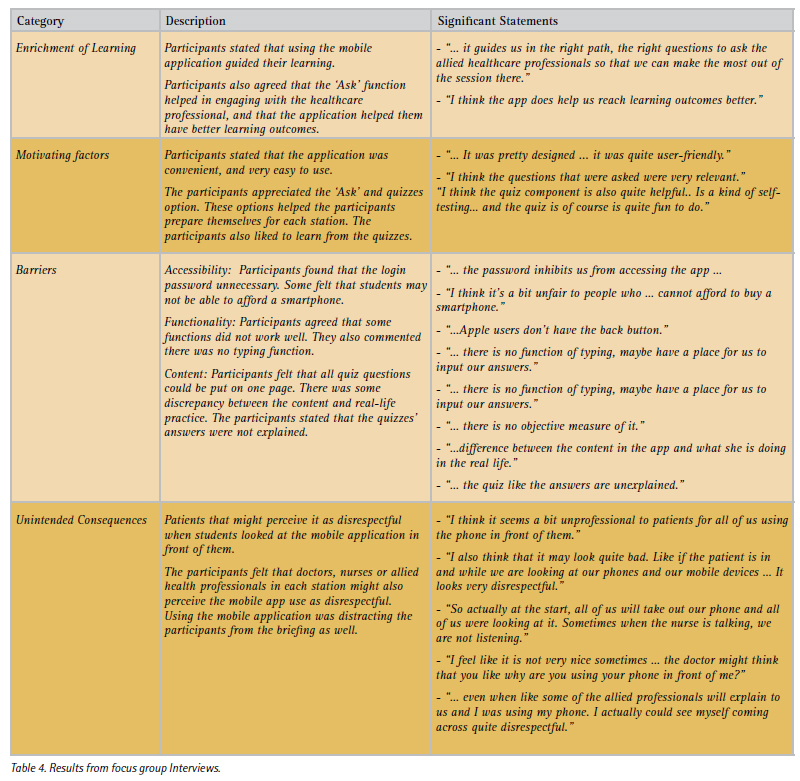
Discussion
The app was well received as a learning tool as the team had hypothesized.
In our focus group discussion, user-friendliness motivated learners to use the app. Learners appreciated the introduction at each service point, the 'Ask' function that facilitated engagement,
and the quiz questions after each educational interaction.
Suggestions to further improve the app include: minimizing the
discrepancy between app content and real world experience,
providing clear "help" and "error" messages, and providing 'exit',
'undo' and 'redo' functions. Learners found the login password
unnecessary, and noted minor bugs in the application software.
The advantages of using Mobile apps to understand the pointsof-
service at the polyclinic include: Learners could self- or groupnavigate
between different points-of-care, to receive just-in-time
learning through app-encouraged interactions (Before, Ask, After)
with the healthcare staff at each point of service, without the use
of additional manpower.
Distracting and Disrespectful
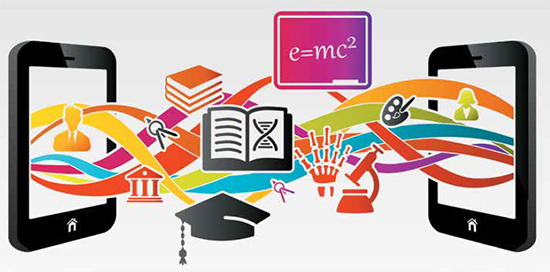 An interesting outcome of this study was the finding that
students thought that use of the app could be both distracting
and disrespectful. An interesting outcome of this study was the finding that
students thought that use of the app could be both distracting
and disrespectful.
So although this qualitative study shows that learning about
the healthcare service points at the polyclinic using the IPTeam
app is feasible and has high user acceptability among medical
students, educators and users of m-learning in their learning
activities need to be mindful of mobile phone etiquette in the
planning of their programs. The concerns quite rightly raised by
the students underline the need to find the right balance in the
use of technology-enablers in teaching without detracting from
what is most central in medical education: the relational aspect
of physician training.
 Click here to download the full issue for USD 6.50 Click here to download the full issue for USD 6.50
|


 he Singapore polyclinic has evolved to efficiently
provide a comprehensive range of services to screen,
prevent, and manage the range of medical conditions
of epidemiological importance to the Singapore population. These
services range from the immunization and screening of children,
to the care of elderly patients with multiple chronic medical
conditions (medical conditions that require long-term medication
and follow up). In this article, we write about a qualitative study
to evaluate the reactions of medical students to a mobile app
employed to learn about healthcare services within the polyclinic.
he Singapore polyclinic has evolved to efficiently
provide a comprehensive range of services to screen,
prevent, and manage the range of medical conditions
of epidemiological importance to the Singapore population. These
services range from the immunization and screening of children,
to the care of elderly patients with multiple chronic medical
conditions (medical conditions that require long-term medication
and follow up). In this article, we write about a qualitative study
to evaluate the reactions of medical students to a mobile app
employed to learn about healthcare services within the polyclinic.
 In the 2010 Primary Care Survey1 conducted by the Ministry of
Health, of the close to 12,000 patients who consulted at the then
18 polyclinics in one day (at present, there are 19 polyclinics), 40%
of the consultations were primarily for chronic medical conditions.
Typically an individual patient with chronic disease will be seen by
a team of healthcare professionals at various service points within
the polyclinic. For instance, a patient with diabetes mellitus gets
his blood taken by the laboratory technician, he may then have
his eyes checked at the retinal photography station, get his feet
checked for numbness at the nursing station, have a medical
consult with the family physician, and then collect the medication
that is dispensed by the pharmacist. In addition, he may have an
appointment at the dietitian's office with his wife, and he may
need to consult the nursing-trained care manager to learn about
home glucose monitoring.
In the 2010 Primary Care Survey1 conducted by the Ministry of
Health, of the close to 12,000 patients who consulted at the then
18 polyclinics in one day (at present, there are 19 polyclinics), 40%
of the consultations were primarily for chronic medical conditions.
Typically an individual patient with chronic disease will be seen by
a team of healthcare professionals at various service points within
the polyclinic. For instance, a patient with diabetes mellitus gets
his blood taken by the laboratory technician, he may then have
his eyes checked at the retinal photography station, get his feet
checked for numbness at the nursing station, have a medical
consult with the family physician, and then collect the medication
that is dispensed by the pharmacist. In addition, he may have an
appointment at the dietitian's office with his wife, and he may
need to consult the nursing-trained care manager to learn about
home glucose monitoring.
 We named the app "IPTeam Polyclinic": "IPteam" in order to
recognize the inter-professional nature of the team of healthcare providers at the polyclinic, and "polyclinic" to situate the context
in which the learning app was to be used.
We named the app "IPTeam Polyclinic": "IPteam" in order to
recognize the inter-professional nature of the team of healthcare providers at the polyclinic, and "polyclinic" to situate the context
in which the learning app was to be used.
 Data Analysis
Data Analysis

 An interesting outcome of this study was the finding that
students thought that use of the app could be both distracting
and disrespectful.
An interesting outcome of this study was the finding that
students thought that use of the app could be both distracting
and disrespectful.
 Click here to download the full issue for USD 6.50
Click here to download the full issue for USD 6.50